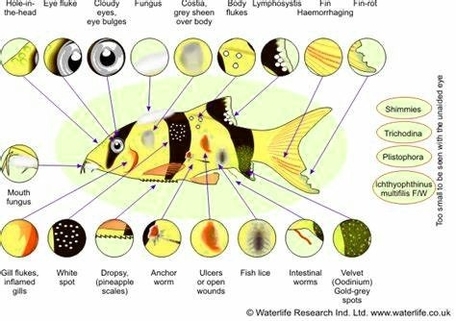Tropical Aquarium Fish Diseases
Aquarium fish diseases can be a challenging aspect of fishkeeping. They can be broadly categorized into parasitic, bacterial, viral, and fungal diseases. Here’s an overview of some common diseases:
1. Parasitic Diseases: Parasites can cause significant harm to fish. For instance, anchor worms, a type of parasitic crustacean, attach to the fish’s skin and bury their heads into their muscles. Symptoms include red and inflamed scales, and the parasites’ bodies may appear as whitish-green threads on the fish.
2. Bacterial Diseases: Bacterial infections often occur after an injury. Poor water quality and diet can stress fish, leading to a weakened immune system and increased susceptibility to bacterial infections. Symptoms include red spots on the body, ulcers on gills, enlarged eyes, and a swollen abdomen.
3. Viral Diseases: Viral diseases can cause growths on fins and body. Lymphocystis is a common viral disease in fish.
4. Fungal Diseases: Fungal infections often appear as white or grey patches on the fish’s skin. They usually occur when the fish is stressed or injured.
Prevention and Treatment
Preventing fish diseases involves several strategies:
– Quality Diet: Providing the right diet for each species can prevent many diseases.
– Good Water Conditions: Maintaining clean, well-filtered water is crucial.
– Regular Observation: Observing fish daily helps catch diseases early.
– Reducing Stress: Avoid overstocking the aquarium and monitor water conditions to reduce stress.
Treatment of diseases depends on the specific disease. Parasitic diseases can often be treated with anti-parasitic medications and water changes. Bacterial infections are typically treated with antibiotics. Always consult a vet or a fish health professional for accurate diagnosis and treatment.
In conclusion, understanding and identifying common tropical fish diseases is crucial for successful fishkeeping. Regular observation, maintaining good water conditions, and providing a quality diet can help prevent many of these diseases. However, if a disease does occur, prompt and appropriate treatment is essential.


